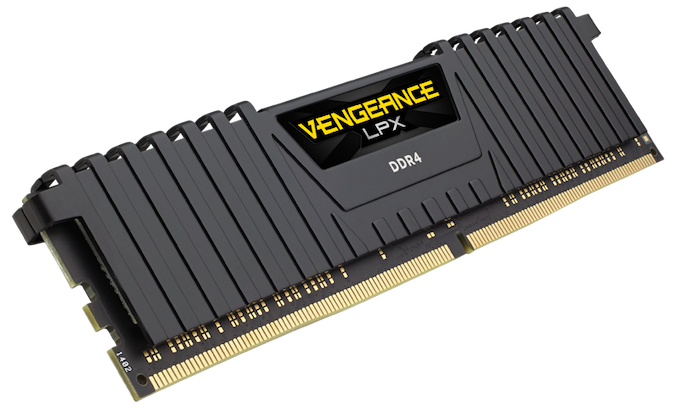Corsair Unveils 32 GB Vengeance LPX DDR4 DIMMs, 64 GB & 128 GB Dual-Channel Kits
by Anton Shilov on July 19, 2019 11:00 AM EST
Corsair has introduced its first 32 GB unbuffered DRAM modules along with 64 GB and 128 GB dual-channel memory kits for mainstream PC platforms based on AMD’s 400/500-series as well as Intel’s 300-series chipsets (and their successors). Besides, the company also unveiled its 256GB eight-channel kit for high-end desktop as well as extreme workstation processors.
Corsair’s Vengeance LPX DDR4 unbuffered memory modules are based on 16 Gb memory chips (from an unconfirmed vendor, though Corsair historically relies on devices from Samsung) as well as the company’s custom 10-layer PCB designed to ensure quality signaling when operating at higher clocks. Traditionally for this product family, Corsair’s 32 GB Vengeance LPX UDIMMs are equipped with black anodized aluminum heat spreaders.
Set to be available in kits containing one, two, four, or eight 32 GB unbuffered DIMMs, Corsair’s Vengeance LPX modules are rated for DDR4-2400 CL16 16-16-39 at 1.2 V, DDR4-2666 CL16 18-18-35 at 1.2 V, and DDR4-3000 CL16 20-20-38 at 1.35 V modes. It is noteworthy that the modules come with SPD programmed for DDR4-2133 CL15 mode, but since they feature XMP 2.0 profiles, setting correct speeds should be easy.
| Corsair Vengeance LPX DDR4 Kits Featuring 32 GB UDIMMs | |||||||||
| Data rate | Latency | Kit Capacity | Modules | Voltage | Heat Spreader | Launch Price | |||
| 2400 MT/s | CL16 16-16-39 |
32 GB | 1 × 32 GB | 1.2 V | Black | $149.99 | |||
| 64 GB | 2 × 32 GB | $299.99 | |||||||
| 128 GB | 4 × 32 GB | $599.99 | |||||||
| 256 GB | 8 × 32 GB | $1,199.99 | |||||||
| 2666 MT/s | CL16 18-18-35 | 32 GB | 1 × 32 GB | 1.2 V | $154.99 | ||||
| 64 GB | 2 × 32 GB | $304.99 | |||||||
| 128 GB | 4 × 32 GB | $609.99 | |||||||
| 256 GB | 8 × 32 GB | ? | |||||||
| 3000 MT/s | CL16 20-20-38 | 32 GB | 1 × 32 GB | 1.35 V | ? | ||||
| 64 GB | 2 × 32 GB | ? | |||||||
Corsair’s 32 GB Vengeance LPX DDR4 unbuffered memory modules as well as kits on their base are available today directly from Corsair and will shortly be available from the company’s partners. One 32 GB DDR4-2400/DDR4-2666 module is priced at $149.99/$154.99; but dual, quad, and eight-channel kits are naturally more expensive.
Related Reading:
- Samsung 32GB DDR4-2666 Non-ECC Memory at Retail: $168
- ADATA Demonstrates 32 GB DDR4 Modules, Built on Micron 16 Gb
- Crucial 32 GB DDR4 Modules Found in an ASRock System
Source: Corsair











19 Comments
View All Comments
samerakhras - Friday, July 19, 2019 - link
Xeons that support 1TB of ECC memory can take 256GB non ECC memoryrolfaalto - Friday, July 19, 2019 - link
Corsair is claiming x299 compatibility. Tempted to buy some: https://www.corsair.com/uk/en/Categories/Products/...haukionkannel - Friday, July 19, 2019 - link
Interesting to see if these 2•32Gb is better than 4•16Gb in daysy chain motherboard... I really like to have 64 of memory in my Computer again... feels nostalgig ;) commadore 64 again :)DanNeely - Friday, July 19, 2019 - link
Whichever has better overall timings and transfer rates will win, which looks like 4x16 at present.All things equal 1 dimm/channel should have better timings than the same ram at 2 dimm/channel.
But in this case everything isn't equal. Corsair Vengeance 4x16 DDR4-3000 has 15-17-17-35 timings to the new 2x32 DDR4-3000 16-20-20-38 which is slightly slower. That's probably a combination of the chips higher capacities making the internal switching more complex and the chip physically larger on one hand, and 32Gb dram being a less mature product. The second half of this should improve over time.
16 GB dimms are also available in significantly faster data rates, although due to the need to relax internal timings within Ryzen 3 to go above DDR-3200(?); the really high transfer rate ram probably only actually gives a net advantage on Intel systems.
On the whole though, outside of ram benchmarks a few points on the timing isn't going to make a difference; I'd probably go with 2x32 to leave a cheaper and easier upgrade path to 4x32 in the future.
brutuscat2 - Friday, July 19, 2019 - link
These are dual rank modules using 16Gb ICs.sonicmerlin - Saturday, July 20, 2019 - link
Price per GB doesn't seem to have dropped much over the last 5-7 years. It pales in comparison to the $/GB decline of SSDs. Why does DDR remain so expensive?nandnandnand - Sunday, July 21, 2019 - link
The stagnation definitely started around 2012, and today we are around 2012's price-per-GB. It's probably due to a number of factors, including industry consolidation, collusion (price fixing), disasters/accidents, change from DDR3 to DDR4, weak/uncertain PC demand, and greater demand elsewhere (smartphones and servers).There had been periods of stagnation in previous decades, but this one is the worst and longest. If there had been no stagnation, we might be looking at $1/GB right now.
https://jcmit.net/mem2015.htm
eldakka - Monday, July 22, 2019 - link
"Corsair historically relies on devices from Samsung)"That could be bad news for them if this Japan-S.Korea trade-war drags on for much longer.
aussetg - Monday, July 29, 2019 - link
I guess those are Samsung M-dies.